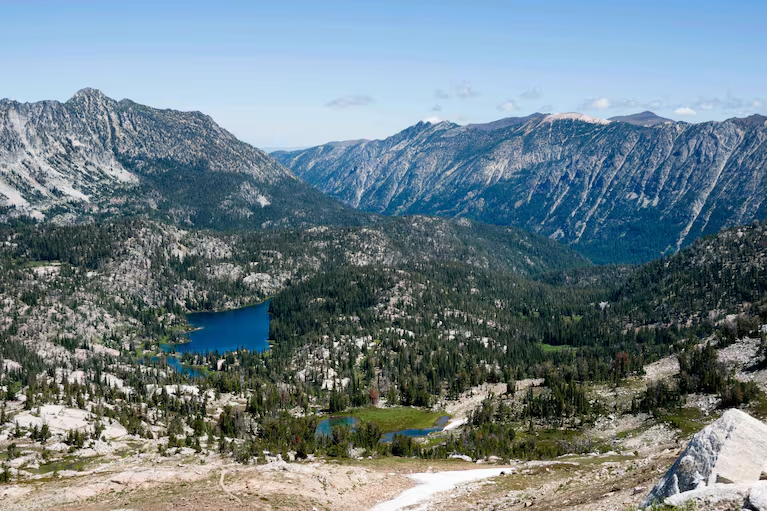For more than 15 years, Oregonians have debated how to manage the vast and rugged Blue Mountains — a sprawling landscape of canyons, forests, and high desert that stretches across nearly five million acres of northeast Oregon. The argument has long centered on a familiar balancing act: how to sustain logging, ranching, mining, recreation, and conservation in one of the state’s most ecologically and economically diverse regions.
Now, with a new U.S. Forest Service land management plan on the table, hope and skepticism are once again colliding. The agency has opened public comment on its draft preliminary plan for the Malheur, Umatilla, and Wallowa-Whitman National Forests — collectively known as “the Blues.” Residents, tribes, environmental groups, and industry stakeholders have until Monday to share their views before the next stage of planning begins.
If finalized, the plan will guide how the federal government manages this vast ecoregion for the next 15 years, shaping decisions about forest restoration, wildfire management, grazing rights, and timber harvests. But with the ongoing federal government shutdown and severe staffing cuts under the Trump administration, many question whether the Forest Service can complete the process at all.
Also Read
A Long History of False Starts
This is not the first time the Forest Service has tried to chart a new course for the Blues. Earlier plans — drafted in 2015 and 2019 — were both withdrawn after intense public backlash. Critics from every corner of the debate called them either too rigid or too complex, leaving the region’s forests operating under outdated management guidelines from the 1990s.
“This is a big plan that’s very important, and there are so many people with a stake in it,” said Alyssa Cudmore, senior forest program manager at Wallowa Resources, a local nonprofit that works with landowners and businesses. “Anytime you have a problem that’s this big and wicked, it’s really hard to find that middle ground.”
The current draft is more of a framework than a rulebook — intentionally broad and light on mandates. Specifics will come later in a draft environmental impact statement (EIS), which the Forest Service says it hopes to release within a year.
Unless, of course, the public’s role continues to shrink. Under the Trump administration, opportunities for public input on environmental decisions have been scaled back — something advocates fear could limit transparency in this process as well.
A Region Rooted in Fire and Change
The Blue Mountains earned their name in the 19th century, when settlers journeying west described the distant ridges glowing under a blue haze. But long before that, the Cayuse, Umatilla, and Nez Perce tribes had been shaping this land through the controlled use of fire — burning underbrush to promote regrowth and food sources.
Over time, industrialization transformed that natural balance. Logging boomed, ranching expanded, and fire suppression became policy. Roads cut deep into once-isolated wilderness, while aggressive firefighting halted the natural regeneration cycle. Add to that a century of human-caused climate change — hotter, drier summers and longer fire seasons — and the landscape today bears little resemblance to its pre-colonial form.
“Everything we do to these forests comes back around,” Cudmore said. “When we suppress every fire, we make the next one worse. When we harvest without balance, we lose resilience. The Blue Mountains are a reminder that our management choices echo for generations.”
A Divided Response
Even in draft form, the new plan has already drawn criticism from multiple sides. Conservationists say it’s too weak; industry advocates argue it’s too vague.
“It was so confusing to interpret that nobody was happy with it,” recalled Jamie Dawson, conservation director at the Greater Hells Canyon Council, describing the previous 2019 plan. “Motorized access groups weren’t happy, conservationists weren’t happy, and county commissioners weren’t happy.”
Now, Dawson says, the Forest Service seems to have gone too far in the opposite direction.
“Instead of being overly prescriptive, they’ve stripped it down so much that it doesn’t actually solve anything,” she said. “It feels like they’re avoiding conflict rather than addressing it.”
Don George, president of Forest Access For All, agrees that the agency has erred — but for different reasons. “They’ve tried so hard to get a forest plan that pleases everyone that they’ve made it too generic,” he said. “It’s not specific enough to be effective.”
The Language Shift: From ‘Must’ to ‘Should’
One of the biggest changes from past plans is in the wording itself. John Persell, senior staff attorney with Oregon Wild, notes that earlier versions contained clear, enforceable directives — words like shall and must. The new plan replaces those with softer phrasing like should and encouraged.
“All of the mandatory language is gone,” Persell said. “They’ve moved to a guideline model that’s aspirational rather than binding. That means there’s no guarantee that protections for large, old trees — or other key resources — will actually hold.”
Critics say the vagueness could leave too much discretion to future administrators, potentially undoing years of progress on conservation and sustainable resource management.
An Uncertain Future for the Blues
Many Forest Service employees who might otherwise clarify the plan’s intent are currently furloughed due to the federal shutdown. That has left stakeholders frustrated by a lack of communication and transparency.
The agency has promised a more detailed draft environmental impact statement by next year, which will outline several potential management options and analyze their environmental consequences. Once released, the public will again have the opportunity to comment — though that could change depending on political directives from Washington.
Until then, the debate continues to simmer.
The Blue Mountains, stretching from the John Day Fossil Beds and the Painted Hills to the Zumwalt Prairie and Hells Canyon, are more than just a landscape — they’re a reflection of Oregon’s ongoing struggle to reconcile ecology, economy, and identity.
As Cudmore put it, “We all love these lands for different reasons — for work, for recreation, for beauty, for heritage. But if we can’t figure out how to share them, we risk losing what makes them special in the first place.”
Whether this long-awaited plan becomes a roadmap for cooperation or yet another casualty of conflict depends on what happens in the months ahead — and whether the federal government can finally bring the future of the Blues into focus.












